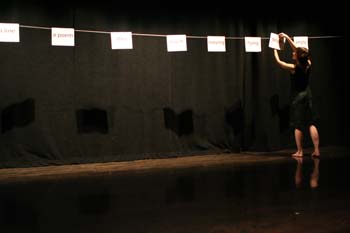|
artforum.com
500 Words July 28, 2011
read here.
The New York Times
March 18, 2011
" 'I'm obsessed with the movement of ideas and the choreography of language,' types Aynsley Vandenbroucke, her words projected on a screen. Those thoughts pervade "Untitled," a piece in which no one dances, but thoughts about dance and our relationship to art are gently, poetically, presented."
Read the full review of recent Danspace Project Performance here.
Danspace Project Blog
March 22, 2011
"Its staging is simple: a series of written dialogues between Vandenbroucke and her past, Vandenbroucke and her present, and Vandenbroucke and her artistic collaborator, Brian Rogers. These dialogues range from the mundane (the experience of making a dance), to the personal (experiences of personal failures, frustrations, childhood memories, artistic influences), to the philosophical (what it means to begin and/or end something, why things (dances) matter)."
read more here.
The New York Times
December 12, 2009
A Number of Small Black and White Dances is a "tender reimagining of the past, and a sophisticated rumination on how an ephemeral art form can survive while staying true to its fragile, mutable essence."
Read More
New York Press
December 9, 2009
"An inquisitive, rigorous process lies behind each of Aynsley Vandenbroucke's dance works.... She creates meticulously distilled pieces in which she scrupulously avoids falling back on movement that is learned or familiar."
Read More
Village Voice feature article on Aynsley and Mount Tremper Arts, May 2009
Blog discussion on AVMG's "3 Dancers, 4 Chairs, 26 Words"
WNYC Performance Club Blog, May 2009
|
"Aynsley Vandenbroucke is an elegant, sensitive thinker." |
Claudia La Rocco
The New York Times, May 2009
|
"There is a certain appealing simplicity about Aynsley Vandenbroucke's "3 Dancers, 4 Chairs, 26 Words," which opened on Thursday night....For the most part, the women don't dance in any traditional sense of the word. Ms. Vandenbroucke creates clear, pared-down movement, walking and turning, gestures to the side, a hand to the face, that works well with the allusive, associative piece, lighted with shadowy care (and huge Kara Walker-like shadows) by Nelson R. Downend Jr. '3 Dancers ' is modest in its aims. But it has an integrity that many grander projects don't achieve." read more |
Roslyn Sulcas
The New York Times, May 2009
|
"An investigation into the relative abstractions of movement and verbal language, it's a kind of cross between refrigerator-magnet poetry and musical chairs. Since the twenty-six words include man,woman,and child, along with sea, grave, and flying, a story keeps coalescing. The word touch shouldn't necessarily turn the story into one of longing, but it does." |
Brian Seibert
The New Yorker, May 2009
Aynsley 51% WAMC Radio interview by Susan Barnett 2008
| | Vandenbroucke's seamless and sensory integrated gathering ended my overflowing New York day. Sitting with strangers looking across to each other in the darkened space, listening carefully to sparks of live sound, the evening provided what Eric Hawkins used to call immediacy. |
Marilyn Russo
Attitude, The Dancers' Magazine, Summer 2008
| | It's like moving philosophy. |
Audience Member, Fall 2008
|
|
In her new trio "And How Should I Begin?," the gifted young choreographer struggles with T. S. Eliot's "The Love Song of J. Alfred Prufrock." The poem is both muttered sotto voce and recited outright, and Vandenbroucke draws upon its teacups, sprawled bodies, magic lanterns, and mermaids riding the waves. Yet the dance, measured out in super-brief vignettes, is strongest when it treats the poem's melancholy obliquely, using photocopies of the poem to wall off or connect the dancers. |
Brian Seibert
The New Yorker, April 2007
|
| ...I found the experience dazzling. |
Levi Asher
Litkicks.com, April 2007
Link to article and interview by Levi Asher
|
Aynsley Vandenbroucke Movement Group's "And How Should I Begin?" borrows heavily from T.S. Eliot's poem "The Love Song of J. Alfred Prufrock" while being a wholly imaginative visual poem of its own. Her work shows thoughtfulness, dedication and pluck. [The piece] asks a simple question, answers with a wealth of variations, and leaves a lot of room for the viewer to also ask, and how should I begin? No matter how, just get started. |
|
Marilyn Russo
Attitude The Dancers' Magazine, Summer 2007
|
The work of this talented young choreographer has invited comparisons to Cunningham and Butoh, but it more boldly recalls the very beginnings of modern dance. |
|
Brian Seibert
The New Yorker, May 2006
|
| The hazards in a mysterious, quite intriguing excerpt from Aynsley Vandenbroucke's "Full Circle" are more playful in nature. To live music by Leanne Darling, and in near total darkness, two women in white train flashlights on two others-making them jump-rope over beams, penning them in, spotlighting their squiggling feet before each gets her own lamp and tries in vain to pinpoint everyone else's fast-moving steps.
|
Deborah Jowitt
The Village Voice, September 2006
|
| Watching Aynsley Vandenbroucke's "Seven Times Fall Down, Eight Times Get Up" on Thursday night was like attending a service in an unfamiliar house of worship, ritualistic, meditative. |
Jack Anderson
The New York Times, April 2005
|
| Aynsley Vandenbroucke is an intriguing young choreographer, exploring extremes, essences of emotions and actions. Her work is thoughtful, intense, minimalist, puzzling. Its images hold in your mind, inviting you back to ask questions, rethink aesthetic assumptions. |
Martha Myers
Dean Emeritus of the American Dance Festival
|
The young choreographer’s new “Seven Times Fall Down, Eight Times Get Up” reveals her gift for simple, strong images.
|
|
Brian Seibert
The New Yorker, May 2005
|
| It was refreshing and recuperative for me in ways I rarely experience in theater…. Shadow plays. Going to extremes...Spinning, Laura Dean, Kai Ta Kai, Murray Spalding come to mind. Full commitment. Simplicity of gesture. No random movement. Clear development. Minimal, but fully dynamic. |
Ellen Goldman, CMA
author of As Others See Us and Geometry of Movement
|
|
|



